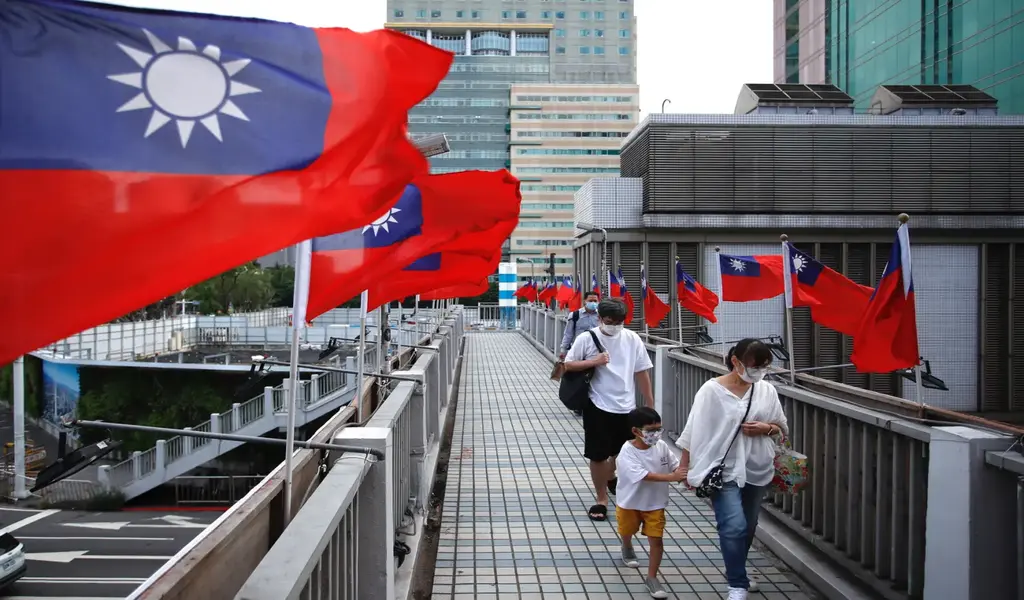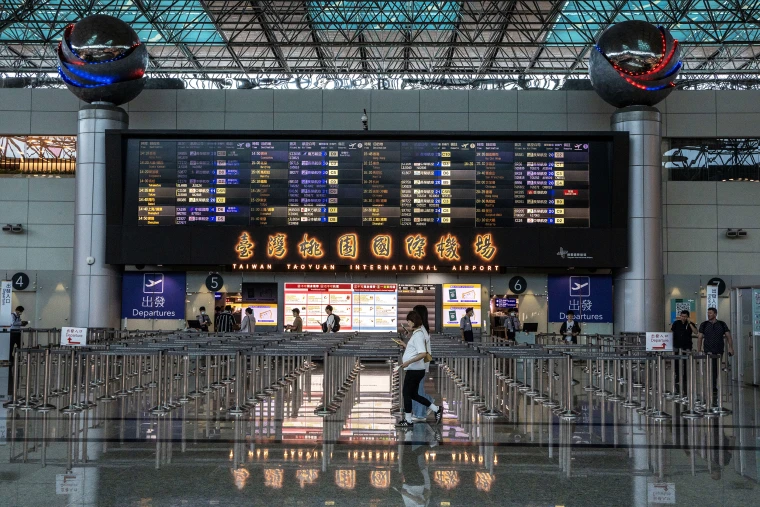World News
China Navy Seeks to “Wear Out” Japanese ships in Disputed Waters
BEIJING – China’s naval and paramilitary ships are churning up the ocean around islands it disputes with Tokyo in what experts say is a strategy to overwhelm the numerically inferior Japanese forces that must sail out to detect and track the flotillas.
A daily stream of bulletins announce ship deployments into the East China Sea, naval combat exercises, the launch of new warships and commentaries calling for resolute defense of Chinese territory.
“The operational goal in the East China Sea is to wear out the Japanese Maritime Self Defence Force and the Japan Coast Guard,” said James Holmes, a maritime strategy expert at the Newport, Rhode Island U.S. Naval War College.
Hundreds of fishing boats are leaving Chinese harbors to converge on and occupy the waters around the Diaoyu Islands. They will be backed by several helicopter patrol ships of the Chinese coast guard.It wasn’t until China became embroiled in the high stakes territorial dispute with Japan late last year that its secretive military opened up.
Now, the People’s Liberation Army (PLA) is routinely telegraphing its moves around the disputed islands, known as Senkaku in Japanese and Diaoyu in Chinese.
News of these missions also has domestic propaganda value for Beijing because it demonstrates the ruling Communist Party has the power and determination to defend what it insists has always been Chinese territory, political analysts said.
However, experts warn that the danger of these constant deployments from both sides into the contested area increases the danger of an accident or miscalculation that could lead to conflict.
In the most threatening incident so far, Tokyo last month said the fire control, or targeting, radar of Chinese warships near the islands “locked on” to a Japanese helicopter and destroyer in two separate incidents in late January.
Beijing denies this but U.S. military officers have backed up Japan’s account.
“We are in extremely dangerous territory here,” said Ross Babbage, a military analyst in Canberra and a former senior Australian defense official.
“We could have had Japan and China in a serious war.”
U.S. Navy and Japan Maritime Self-Defense Force ships underway in Japan waters during Keen Sword exerciseRead more: http://nation.time.com/2012/11/08/big-exercise-low-profile-in-japan-china-dispute/#ixzz2Mo3dezeq
Some foreign and Japanese security experts say Japan’s powerful navy and coast guard still holds the upper hand in the disputed waters but that this could change if Beijing intensifies its patrols.
“I believe China for the time being focuses resources on the South China Sea, which is a higher priority for them now,” said Yoshihiko Yamada, a maritime policy expert and professor at Tokai University.
“But, if they shift more resources to the East China Sea, the coast guard alone would not be able to handle the situation.”
There were signs that tension remained high last week when Tokyo protested that China had deployed a series of buoys around the islands to collect intelligence about Japanese operations.
China’s Foreign Ministry said the buoys were in Chinese waters and positioned to collect weather information.
Beijing’s paramilitary agencies have been equally forthright since the standoff began with a stream of news and footage of their deployments.
Ships from these agencies including customs, maritime surveillance and fisheries are in the frontline of Beijing’s campaign to assert sovereignty over the disputed islands, which are believed to be rich in oil and gas.
A Chinese fisheries surveillance vessel entered Japan’s territorial waters near the islands for the second day running on February 24 in what was the 31st similar incursion since September, the Japanese coast guard said last week.
News bulletins in China are saturated with coverage of Chinese paramilitary ships jostling for position with their Japanese counterparts around the rocky islands.
PRESSURE ON JAPAN COAST GUARD
There is evidence Japan’s coast guard is feeling the pressure.
It plans to form a new, 600-member unit equipped with 12 patrol ships that will be deployed exclusively on missions around the disputed islands.
And, it is boosting its budget to buy ships and aircraft by 23 percent to 32.5 billion yen ($348.15 million) for the year starting in April.
The coast guard also plans to add 119 personnel in the year starting next month. That would be the biggest staff increase in 32 years.
As tension mounted around the islands ahead of his return to office as prime minister of Japan in December, Shinzo Abe proposed converting retired navy vessels into coast guard patrol ships.
Defence Minister Itsunori Onodera said on Tuesday that his ministry and the coast guard were discussing the idea.
Beijing has so far held its navy back from waters immediately surrounding the disputed territory but its warships are almost constantly patrolling nearby seas and other waterways around the Japanese archipelago, according to the PLA announcements.
In late January, the PLA said a naval fleet would conduct a naval exercise in the Western Pacific after “sailing through islands” off the Chinese coast, a clear reference to the Japanese archipelago. The navy had conducted seven similar exercises last year, it said.
In a series of subsequent bulletins, the PLA said three of its most modern warships, the missile destroyer Qingdao and the missile frigates Yantai and Yancheng would make up the fleet which would conduct training in the Yellow Sea and the East China Sea in an 18-day deployment.
The U.S. navy has also monitored the sharply increased tempo of Chinese naval and paramilitary operations near Japan.
In an unusually blunt public assessment, a senior American naval intelligence officer, Captain James Fanell, told a seminar in San Diego on January 31 that the PLA navy had last year sent seven surface action groups into the Philippines Sea south of Japan.
It had also deployed the biggest number of submarines in its history into this area, he said.
It was unclear if Fanell was referring to the same seven deployments the PLA disclosed last month.
“Make no mistake, the PLA navy is focused on war at sea and about sinking an opposing fleet,” Fanell said.
And, the U.S. officer said, China’s maritime surveillance agency, a civil proxy for the PLA, had become “a full-time maritime sovereignty harassment organization” with the goal of enforcing territorial claims.
The frequency of deployments appears set to continue with the PLA announcing on February 27 it would conduct 40 military exercises this year with an increased emphasis on “core security-related interests”.
Senior Chinese officials have strongly implied that Japan’s claim over the islands is an attack on one of China’s core interests, an important distinction to Beijing in defining its non-negotiable national priorities.
In a speech to the politburo in late January, Chinese party leader Xi Jinping referred to the pain of “wartime atrocities”, an apparent reference to Japan’s bloody invasion and occupation of China last century, according to a report of his remarks carried by the official Xinhua news agency.
“We will stick to the road of peaceful development but will never give up our legitimate rights and will never sacrifice our national core interests,” he was reported to have said.
And, Beijing continues to boost its military firepower. Chinese shipyards last week delivered a new, stealth frigate to the navy, the official PLA Daily newspaper reported.
The radar evading type-056 frigate would be introduced in big numbers as the first step in a systematic upgrade of navy hardware, the paper said.
BUT JAPAN SAYS IT WON’T BUCKLE
Despite the intense military and diplomatic pressure, the Japanese government shows no sign of wilting.
“We simply cannot tolerate any challenge now and in the future,” Prime Minister Abe said recently in Washington.
“No nation should make any miscalculation or underestimate the firmness of our resolve.”
Still, military analysts said Japanese forces must continue to match China’s patrols and exercises.
In a paper prepared for an Australian military think tank last year, an influential Japanese military strategist, retired Vice Admiral Yoji Koda, said Chinese naval forces sailing around the Japanese islands “will surely meet intensive surveillance and continuous tracking” from Japanese forces and its U.S. allies.
Some military analysts suggest Beijing’s continuous deployments around the Diaoyu/Senkaku islands are also part of a wider policy of enhancing its claims over a number of disputed territories in the East China Sea and South China Sea.
“If Beijing starts policing territory it claims as its own, and if rival claimants can’t push back effectively, it will start looking like the rightful sovereign over that territory,” said Holmes.
However, Holmes added that Japan poses a much stiffer challenge for Beijing than smaller nations like the Philippines which also has overlapping territorial claims with China.
While smaller in raw numbers than the PLA navy, the highly trained Japanese navy is generally regarded as the most powerful in Asia with state-of-the art ships, submarines and aircraft. And, it has a security alliance with the United States that obliges Washington to intervene if Japan is attacked.
Other military experts suggest Beijing has decided to intensify its operations against Japan, a nation whose wartime aggression is remembered across Asia, because confrontations with smaller neighbors in recent years had led to a region-wide diplomatic backlash.
“The Senkaku/Diaoyu hoopla of late is triggered by China’s desire to extricate itself from total regional isolation caused by China’s expansive territorial claims against virtually all of its maritime neighbors,” said Yu Maochun, an expert on the PLA at the Annapolis, Maryland United States Naval Academy. ($1 = 93.3500 Japanese yen)
by Kiyoshi Takenaka in Tokyo

World News
Marine Le Pen’s National Rally Wins the First Round in France 2024 Election

Exit polls in France showed that Marine Le Pen’s right-wing National Rally (RN) party made huge gains to win the first round of election on Sunday. However, the final outcome will depend on how people trade votes in the days before next week’s run-off.
Exit polls from Ipsos, Ifop, OpinionWay, and Elabe showed that the RN got about 34% of the vote. This was a big loss for President Emmanuel Macron, who called the early election after his party lost badly in the European Parliament elections earlier this month.
The National Rally (RN) easily won more votes than its opponents on the left and center, including Macron’s Together group, whose bloc was predicted to get 20.5% to 23% of the vote. Exit polls showed that the New Popular Front (NFP), a hastily put together left-wing alliance, would get about 29% of the vote.
The results of the exit polls matched what people said in polls before the election, which made Le Pen’s fans very happy. But they didn’t say for sure if the anti-immigrant, anti-EU National Rally (RN) will be able to “cohabit” with the pro-EU Macron in a government after the runoff election next Sunday.
Voters in France Angry at Macron
Many French people have looked down on the National Rally (RN) for a long time, but now it is closer to power than it has ever been. A party known for racism and antisemitism has tried to clean up its image, and it has worked. Voters are angry at Macron, the high cost of living, and rising concerns about immigration.
Fans of Marine Le Pen waved French flags and sang the Marseillaise in the northern French district of Henin-Beaumont. The crowd cheered as Le Pen said, “The French have shown they are ready to turn the page on a power that is disrespectful and destructive.”
The National Rally’s chances of taking power next week will rest on what political deals its opponents make in the next few days. Right-wing and left-wing parties used to work together to keep the National Rally (RN) out of power, but the “republican front,” which refers to this group, is less stable than ever.
If no candidate gets 50% of the vote in the first round, the top two candidates and anyone else with 12.5% of the registered voters immediately move on to the second round. The district goes to the person who gets the most votes in the runoff.
France is likely to have a record number of three-way runoffs because so many people voted on Sunday. Experts say that these are much better for the National Rally (RN) than two-way games. Almost right away on Sunday night, the horse trade began.
Macron asked people to support candidates who are “clearly republican and democratic.” Based on what he has said recently, this would rule out candidates from the National Rally (RN) and the hard-left France Unbowed (LFI) party. Leaders on the far left and the center left both asked their third-placed candidates to drop out.
Minority government
Jean-Luc Melenchon, leader of France Unbowed, said, “Our rule is simple and clear: not a single more vote for the National Rally.” But the center-right Republicans party, which split before the vote when some of its members joined the RN, didn’t say anything.
The president of the RN party, Jordan Bardella, who is 28 years old, said he was ready to be prime minister if his party gets a majority of seats. He has said he won’t try to make a minority government, and neither Macron nor the communist NFP will work with him.
“I will be a “cohabitation” Prime Minister, respectful of the constitution and of the office of President of the Republic, but uncompromising about the policies we will implement,” he said.
A few thousand anti-RN protesters met in Paris’s Republique square on Sunday night for a rally of the leftist alliance. The mood was gloomy.
Niya Khaldi, a 33-year-old teacher, said that the RN’s good results made her feel “disgust, sadness, and fear.”
“This is not how I normally act,” she said. “I think I came to reassure myself, to not feel alone.”
Election Runoff
The result on Sunday didn’t have much of an effect on the market. In early Asia-Pacific trade, the euro gained about 0.23%. Fiona Cincotta, a senior markets expert at City Index in London, said she was glad the outcome “didn’t come as a surprise.”
“Le Pen had a slightly smaller margin than some of the polls had pointed to, which may have helped the euro a little bit higher on the open,” she noted. “Now everyone is waiting for July 7 to see if the second round supports a clear majority or not. So it does feel like we’re on the edge of something.”
Some pollsters thought the RN would win the most seats in the National Assembly, but Elabe was the only one who thought the party would win all 289 seats in the run-off. Seat projections made after the first round of voting are often very wrong, and this race is no exception.
On Sunday night, Reuters reported there were no final results for the whole country yet, but they were due in the next few hours. In France, exit polls have usually been very accurate.
Voter turnout was high compared to previous parliamentary elections. This shows how passionate people are about politics after Macron made the shocking and politically risky decision to call a vote in parliament.
Mathieu Gallard, research head at Ipsos France, said that at 1500 GMT, nearly 60% of voters had turned out, up from 39.42% two years earlier. This was the highest comparable turnout since the 1986 legislative vote. It wasn’t clear when the official number of people who voted would be changed.
World News
Pakistan Seeks US Support for Counter-Terrorism Operation Azm-e-Istehkam

(CTN News) – Pakistan’s Ambassador to the United States, Masood Khan, has urged Washington to provide Pakistan with sophisticated small arms and communication equipment to ensure the success of Operation Azm-e-Istehkam, a newly approved counter-terrorism initiative in the country.
The federal government recently approved the reinvigorated national counter-terrorism drive, which comprises three components: doctrinal, societal, and operational.
Ambassador Khan noted that work on the first two phases has already begun, with the third phase set to be implemented soon.
Addressing US policymakers, scholars, and corporate leaders at the Wilson Center in Washington, Khan emphasized the importance of strong security links, enhanced intelligence cooperation, and the resumption of sales of advanced military platforms between Pakistan and the US.
He argued that this is crucial for regional security and countering the rising tide of terrorism, which also threatens the interests of the US and its allies.
“Pakistan has launched Azm-i-Istehkam […] to oppose and dismantle terrorist networks. For that, we need sophisticated small arms and communication equipment,” said Ambassador Khan.
Pakistan–United States relations
The ambassador observed that the prospects of Pakistan-United States relations were bright, stating that the two countries “share values, our security and economic interests are interwoven, and it is the aspiration of our two peoples that strengthens our ties.”
He invited US investors and businesses to explore Pakistan’s potential in terms of demographic dividend, technological advancements, and market opportunities.
Khan also suggested that the US should consider Pakistan as a partner in its diplomatic efforts in Kabul and collaborate on counterterrorism and the rights of women and girls in Afghanistan.
He stressed that the bilateral relationship should be based on ground realities and not be hindered by a few issues.
“We should not base our engagement on the incongruity of expectations.
Our ties should be anchored in ground realities, even as we aim for stronger security and economic partnerships. Secondly, one or two issues should not hold the entire relationship hostage,” said the ambassador.
World News
China Urges Taiwanese to Visit Mainland ‘Without Worry’ Despite Execution Threat

China has reassured Taiwanese citizens that they can visit the mainland “without the slightest worry”, despite Taiwan raising its travel alert to the second-highest level in response to Beijing’s new judicial guidelines targeting supporters of Taiwanese independence.
Last week, China published guidelines that could impose the death penalty for “particularly serious” cases involving “diehard” advocates of Taiwanese independence.
In response, Taiwan’s government urged the public to avoid “unnecessary travel” to mainland China and Hong Kong, and raised its travel warning to the “orange” level.
However, Zhu Fenglian, a spokeswoman for a Chinese body overseeing Taiwan affairs, stated that the new directives are “aimed solely at the very small number of supporters of ‘Taiwan independence’, who are engaged in malicious acts and utterances”.
She emphasized that “the vast majority of Taiwan compatriots involved in cross-strait exchanges and cooperation do not need to have the slightest worry when they come to or leave mainland China”.
“They can arrive in high spirits and leave fully satisfied with their stay,” Zhu added.

What’s Behind The China-Taiwan Tensions?
The tensions stem from the longstanding dispute over Taiwan’s status. Mainland China claims Taiwan as part of its territory and has refused to rule out using force to bring the democratic island under its control, while Taiwan sees itself as a sovereign state.
Beijing has not conducted top-level communications with Taipei since 2016, when the Democratic Progressive Party’s Tsai Ing-wen became Taiwan’s leader. China has since branded her successor, President Lai Ching-te, a “dangerous separatist”.
“The DPP authorities have fabricated excuses to deceive the people on the island and incite confrontation and opposition,” Zhu said in her statement.
Despite the political tensions, many Taiwanese continue to travel to mainland China for work, study, or business.
-

 News4 years ago
News4 years agoLet’s Know About Ultra High Net Worth Individual
-
Entertainment2 years ago
Mabelle Prior: The Voice of Hope, Resilience, and Diversity Inspiring Generations
-
News11 years ago
Enviromental Groups Tell Mekong Leaders Lao Dam Evaluation Process Flawed
-

 Health4 years ago
Health4 years agoHow Much Ivermectin Should You Take?
-

 Tech3 years ago
Tech3 years agoTop Forex Brokers of 2023: Reviews and Analysis for Successful Trading
-

 Lifestyles3 years ago
Lifestyles3 years agoAries Soulmate Signs
-

 Entertainment3 years ago
Entertainment3 years agoWhat Should I Do If Disney Plus Keeps Logging Me Out of TV?
-

 Health3 years ago
Health3 years agoCan I Buy Ivermectin Without A Prescription in the USA?